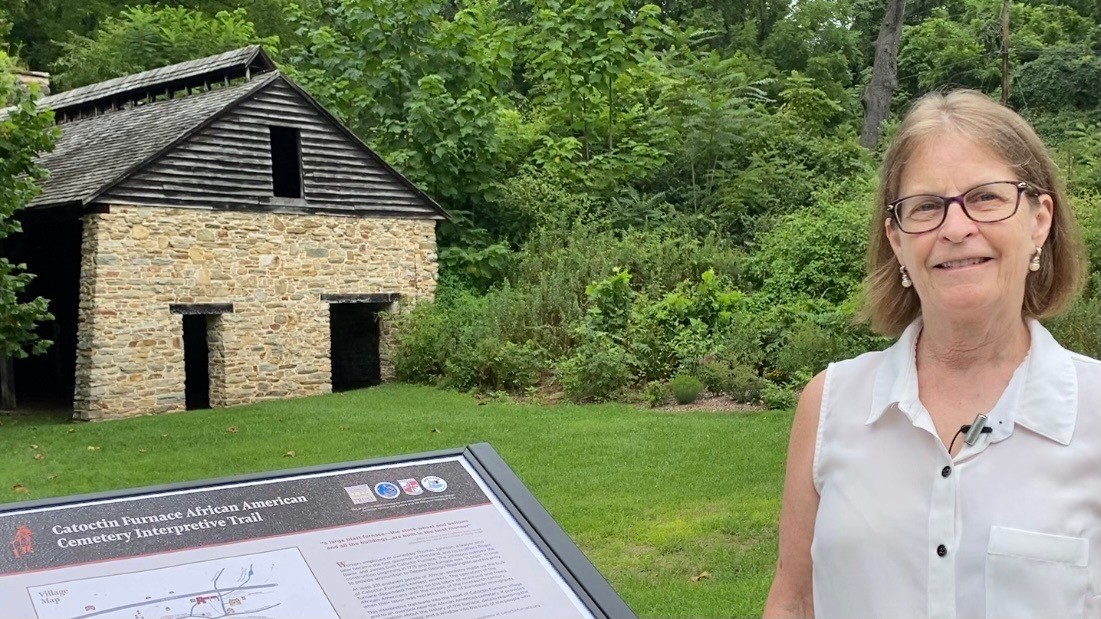Elizabeth “Liz” Anderson Comer ’77

Elizabeth “Liz” Anderson Comer ’77
B. A., History and Political Science
Archaeologist and President, EAC Archaeology, Inc.
Secretary, Catoctin Furnace Historical Society Inc., Thurmont, MD
https://catoctinfurnace.org/
Elizabeth “Liz” Anderson Comer ’77
Graduation Year
1977
Tell us why you chose to attend Hood? Did you know you wanted to major in history when you made your decision?
I matriculated at Hood as an almost-17-year-old early admission student. I graduated high school in nearby Thurmont a year early and was anxious to begin college. Hood was close to home, small, and had an active day student population. I grew up in a historic house, and my parents were very interested in history, so I was introduced to historic sites and history as a very young child. I knew I wanted to be an archaeologist from the time I was 5 years old. As a freshman at Hood, I jumped right into the history department. My interest and desire to explore the past has never wavered.
When you were at Hood, did you have a “high impact experience” such as an internship or research project that influenced your decision to go into the field of historical preservation?
During my sophomore year at Hood, I was able to walk up Rosemont Avenue and participate in an archaeological excavation in the basement of Schifferstadt, the oldest standing house in Frederick, Maryland. As a junior, I was at the University of London taking courses such as Romano-British archaeology. These amazing experiences solidified my desire to pursue graduate work in anthropology with a specialization in archaeology.
Was there a professor at Hood who you would identify as a mentor? How did this person’s influence affect your decisions pre- and post- graduation?
The superb History and Political Science Department classes, especially those taught by Dr. Virginia E. Lewis, Dr. Gerald D. McKnight, and Dr. Leonard Latkovski, gave me a broad background that I was able to parlay into a successful career in archaeology. My favorite class was History 344 with Dr. Leonard Latkovski - “A Century of Revolutions, 1750-1850.”
Tell us about your current position; what does your work day at the Catoctin Furnace site look like? How has the pandemic affected your team and their work?
As a professional archaeologist, I own and manage a firm located in Baltimore that performs archaeology, architectural history, and cultural resource management projects throughout the Mid-Atlantic area. As a volunteer, I serve as secretary of the Catoctin Furnace Historical Society. The pandemic severely impacted the historical society in terms of visibility and loss of momentum. Several major initiatives were postponed, and we realized that it was vital to establish innovative virtual programming to provide visibility and build a desire to visit in-person in the future, when it is safe to reopen. We began producing podcasts, videos, and online events to expand our audience reach. We increased our social media presence and revamped our email template to better communicate and distribute information. These initiatives were assisted by a grant from the National Endowment for the Humanities.
What is your favorite aspect about working at the Catoctin Furnace? If you could choose any other historical preservation project to work on, what would that be and why?
I most enjoy the partnerships I have created and nurtured between the Catoctin Furnace Historical Society, the Smithsonian Institution, and the David Reich Laboratory at Harvard University. Through a DNA, genealogical research, oral history, and online databases, we are searching for the descendant population of the enslaved workers to reunite them with their lost heritage and legacy, thus restoring identity to people and place. While I have a very wide range of interests, there is no other project I would rather be working on at this time.
When speaking with your site visitors, what is the most important message you hope they take home with them after they see the Village and the Furnace?
Visitors who come to the Museum of the Ironworker will presumably also be interested in seeing the larger scenic landscape in which the ironmaking industry developed. The Museum of the Ironworker is something for the public to look forward to in these trying times. Historically, the citizens of Catoctin Furnace survived many hardships, mentally and physically. Their stories provide hope for all of us.
Lastly, what advice would you give current Hood students who were interested in pursuing a career in history and preservation?
Take advantage of every opportunity…especially the ones that seem to be oppositional to your intended path. My experience taught me that one backs into the best circumstances, and those unexpected, unintended, and unforeseen opportunities make all the difference.
Are you ready to say Hello?
Choose a Pathway
Information will vary based on program level. Select a path to find the information you're looking for!
